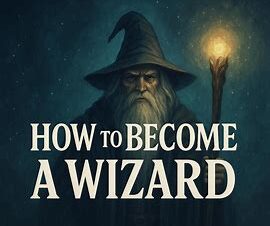“The Path of the Wizard: Foundations of Wisdom”
🎯 Learning Objectives
By the end of this section, you should be able to:
- Define what wizardry means in a real-life, modern context.
- Explain how wizardry differs from religion, science, and fantasy.
- Identify the role of wisdom as the root of wizardry.
- Recognize the “Wizard Colors” and the importance of Indigo Wizardry.
- Begin developing the mindset of a student-wizard: curiosity, responsibility, and self-mastery.
📜 Lecture Script
1. What Is Wizardry, Really?
When most people hear the word “wizard,” they think of Merlin, Gandalf, or Harry Potter. The word brings images of staffs, robes, glowing orbs, and fireballs shot from the fingertips. But in the real world, wizardry is not about stage magic, superstition, or fantasy spells.
The true meaning of the word wizard is “wise one.” At its heart, wizardry is the study and practice of wisdom. It is the lifelong pursuit of knowledge, understanding, and the ability to apply insight to improve both oneself and the world around you.
This course—the Home Study of Wizardry—where wizardry is seen as a modern, secular, and educational discipline. It blends philosophy, science, history, and the arts with imagination, spirituality, and responsibility.
A wizard is not simply someone who knows. A wizard is someone who applies what they know wisely.
2. Wizardry as a Path of Learning
Think of wizardry as a grand library—part philosophy, part science, part art, and part practical craft. A wizard studies many fields:
- History (to learn from the past)
- Science (to understand how the world works)
- Philosophy (to ask why things matter)
- Nature (to live in balance with the Earth)
- Symbols and Language (to grasp how meaning shapes reality)
- Psychology (to know the mind and emotions)
- Mysticism and Metaphysics (to explore the mysteries of being)
But wizardry is not just academics—it is also practice. A wizard does. They experiment, create rituals, practice meditation, plant herbs, study the stars, debate ideas, write journals, and engage in service to their community.
A wizard’s motto could be summed up as: “To know, to dare, to will, and to serve.”
3. Wizardry vs. Religion vs. Fantasy
It’s important to clarify early that wizardry is not a religion. Wizardry is a philosophy, a discipline, and a practice. Wizards may belong to any religion (Christian, Jewish, Muslim, Pagan, Buddhist, or none at all). Wizardry does not replace spiritual faith; instead, it gives tools of critical thinking, observation, and creativity that can complement or stand independent of religious belief.
At the same time, wizardry is not fantasy role-playing. Though we borrow stories of Merlin or Harry Potter for inspiration, this path is about real learning and real personal development. You won’t wave a wand and shoot lightning. Instead, you’ll learn how words, choices, and symbols can be more powerful than any fictional spell.
4. The Wizard Colors
The Grey School divides wizardry into 12 departments, called “colors.” Each color represents a field of study:
- White – Philosophy, ethics, history.
- Red – Healing, vitality, alchemy.
- Orange – Performance, drama, storytelling.
- Yellow – Math, logic, critical thinking.
- Green – Nature, plants, ecology.
- Blue – Time, cycles, divination.
- Indigo – Metaphysics, deep mysteries, higher mind.
- Violet – Mysticism, spirit, transcendence.
- Grey – Lore, languages, symbols.
- Black – Shadow, balance, psychology.
- Silver – Science, modern integration.
- Gold – Leadership, service, wisdom in action.
Each lecture in this course will touch on these, with a heavy focus on Indigo Wizardry, the color of deep thought, inner vision, and metaphysics.
5. The Indigo Wizard’s Place
Why focus on Indigo? In the visible spectrum, indigo is the color between blue and violet—a liminal place, a boundary color. Likewise, Indigo Wizardry focuses on the boundaries between the known and the unknown.
Indigo studies include:
- Meditation and altered states of consciousness
- Dreamwork and symbols
- The study of metaphysics
- The philosophy of being and knowing
- Esoteric traditions
- Deep self-reflection and mastery
Indigo Wizardry teaches us to look beneath appearances and ask: “What is real? What lies beneath? What truth do symbols carry?”
This course will return often to Indigo studies, because they form the backbone of higher wizardry.
6. Wisdom as the Core of Wizardry
The most important thing to remember: wizardry is about wisdom.
- Knowledge is facts.
- Intelligence is the ability to process facts.
- Wisdom is knowing how, when, and why to apply what you know.
King Solomon in the Bible was praised not just for wealth or power, but for wisdom (1 Kings 3:5–12, NASB). Ancient philosophers sought wisdom as the greatest treasure. Wizards, in the modern sense, follow that same pursuit.
A true wizard doesn’t hoard knowledge for pride—they use it for service, for protection, for healing, for teaching.
7. The First Steps of a Student-Wizard
If you are beginning this path, here are three qualities you must start cultivating right away:
- Curiosity – Never stop asking questions. A wizard learns not only from books, but from the stars, from the wind, from people, from mistakes.
- Responsibility – Power is nothing without accountability. “A wizard takes responsibility for their actions.”
- Self-Mastery – Before you can master the mysteries of the world, you must first master yourself: your thoughts, emotions, habits, and words.
Write these down in your journal. Reflect on them daily.
(continued in Part 2: The History and Lineage of Wizards)
📚 References
- Zell-Ravenheart, Oberon. Grimoire for the Apprentice Wizard. New Page Books, 2004.
- Buckland, Raymond. Signs, Symbols & Omens. Llewellyn Publications, 2003.
- Bible, NASB. 1 Kings 3:5–12.
- Grey School of Wizardry. www.greyschool.net
